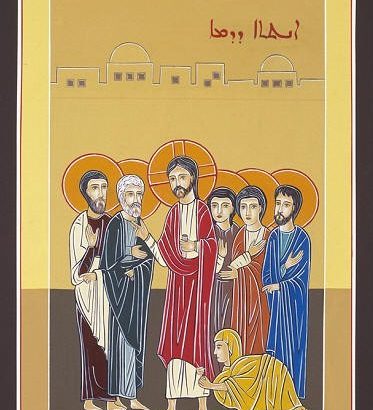Fr Badwi makes only brief remarks about this icon, writing: “Against the background of the previous icon, the haemorrhaging woman touches the fringe of Jesus’ cloak and she is healed. The Lord asked who touched him? Peter answered, and the Apostles were astonished.” The layout of the figures here is very traditional, being based on the Vat. Syr. 559 illustration, even down to the way that Our Lord is shown as being just a little bit higher than the others. One way that ancient art showed the greater respect due to certain people was to portray them as being of greater height. I suspect that the man with grey hair in dark robes is Jairus, the ruler of the synagogue, and that St Peter is standing behind Jairus – on the other side of the haemorrhaging woman. Although the Gospels say that there was a crowd, to portray the throng would clutter the picture, so there are some apostles, Jairus, the woman, and in the very middle of the icon, the Lord Himself. The city of Jerusalem is suggested by the skyline.
Now, in both the Gospels (the story is told in Ss Matthew, Mark and Luke), this account is interwoven or “sandwiched” with the account of the raising of the daughter of Jairus from the dead. Jairus, described as “a ruler of the synagogue”, approaches the Lord. Then Jairus kneels at the Lord’s feet, and asks Him to cure his twelve year old daughter who is dying. The Lord goes off to Jairus’ house, and as He walks, the crowd presses in on Him. Then, we are told, He is approached by the woman who has had a flow of blood for twelve years and had spent her money on physicians. She comes up from behind the Lord, and touches the hem of his garment. As soon as she does, the blood flow stops. The Lord asks who has touched Him, but everyone denies having done so, and Peter even implies that the Lord has mistaken the crush of the crowd for someone touching Him. But the Lord insists: He knew that someone had touched Him, because He felt power going out from Him.
At this point, the trembling woman comes up to the Lord, and says that it was she who had touched Him, and why, and that she had immediately been healed. The Lord then says to her: “Daughter, your faith has saved you. Go in peace!” But the word used, from the verb used (poreuo) is not the usual word for “go,” rather it has the meaning of “travel, conduct yourself.” In other words, it has more a sense of “journey forth and live your life in peace.” Then He went to the house of Jairus where He raised His daughter from the dead.
There is some essential background to this event: the religious garment of the priests can sanctify people. Therefore, the fact that contact with the Lord’s robes could heal the woman shows that He was a priest, and everything he wore was holy. But there is something more at work here, for as Our Lord says, her faith has brought her salvation. So, one part of this account is teaching us that the work of the Old Testament priesthood has been perfected by the priesthood of Christ. This ties in with the fact that in the intertwined story, Jairus is a leader of the synagogue. So, the picture of the story, so to speak, tells us that Our Lord is greater than the Old Testament, and everything connected with it.
In fact, a full understanding of the haemorrhaging woman would require a point by point comparison with Jairus’ daughter. One had been sick for twelve years, and the other was born twelve years ago, and her short life had ended in death, but then the Lord had raised her just as He had raised the bleeding woman. In place of the woman’s faith, the father’s faith sufficed for the girl. The faith of Jairus is shown by two things: his actions in kneeling at the feet of the Lord, and second, when they are told that the girl has died, Jesus says to Jairus: “Only have faith and she will be saved.” Incidentally, for those who argue that infant baptism is impossible because an infant cannot have faith, this shows that Our Lord Himself counted the faith of the parents as that of the child.
Just as the doctors had been unable to do anything for the woman, so the people laughed when Jesus said that the girl was only sleeping. In both cases, therefore, He exceeded the art of any human doctor. But the religious aspect is far more significant than the medical: although the woman should have been polluting because of her condition, and the dead body represented the very highest level of uncleanness. But there is no evidence that the Lord or anyone else considered Himself to be have been polluted. More than simply purifying the unclean, the Lord changed the very condition of the people so that they were no longer unclean at all.
